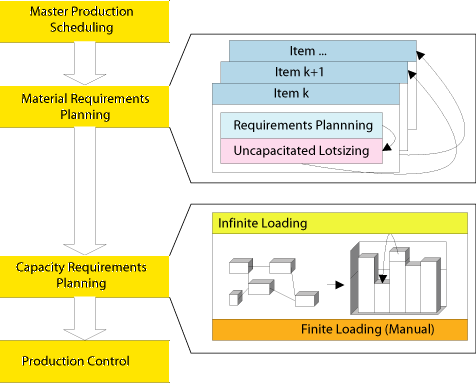Advanced-Planning (original) (raw)
MRP - A Planning System?
The MRP (Material Requirements Planning) concept exists since the 60s of the last century. It is the basis for most software systems supporting production planning and control in industrial practice. Most of these so-called MRP systems provide good assistance for order processing, data handling and inventory book-keeping, but they do not support planning.
A typical MRP system follows a successive planning concept, as depicted in the following figure.

Master Production Scheduling.
Based on existing customer orders and a medium-term aggregate production plan Master Production Scheduling (MPS) prepares a short-term production plan for end or rather main products. The planning result is the Master Production Schedule, which is commonly referred to as the MPS.
Material Requirements Planning.
The next step, Material Requirements Planning (MRP), uses the MPS as a starting point and computes derived demands for all components required for the production of the end products. The planning data used are the bill-of-materials structure (BOM structure, Gozinto structure), the current inventory status (including planned receipts) and planned lead times. Within this planning step lot sizes are computed under the assumption that infinite capacity is available. Result of these computations are planned production quantities per item and period.
» See also: Material Requirements Planning computations
Capacity Requirements Planning.
Next, for each operation required to make the products the planned starting time and ending time are computed with the help of standard project planning algorithms, such as the Critical Path Method (CPM). Again, capacities of the resources are neglected (infinite loading). Following this planning step, the capacity requirements resulting from infinite loading are tabulated and graphed. Usually the comparison with the available capacities shows that the production plan developped so far is infeasible.
This is the point in time when adjustment of the production plan by the human planner comes into play. Usually based on experience, the planner tries to shift operations on the time axis in order to generate a feasible production schedule. If this is not possible due to conflicts between the resource requirements of different operations, the capacity is extended by overtime, if possible. In general, a human does not have the capability to solve this complicated combinatorial optimization problem, which is a variant of the so-called Resource-Constrained Project Planning Problem (RCPSP).
Production Control.
In the last planning, for the upcoming short-term planning horizon production oders are released and assigned to the resources. For each resource orders are scheduled with the help of simple priority rules.
Critique of the MRP concept
Basically, the MRP concept is nothing else than the automation of order processing procedures that in earlier days have been done manually. Planning methods that support decision making in the sense that a feasible production plan is developped are not applied. The MRP concept has been criticized by many scientists as well as practitioners in a large number of publications. Its flaws are system-immanent and cannot be deleted by modern data base methods, user interfaces and faster computers. The major flaws to be criticized are:
| 1. | The medium-term aggregated production planning which aims at the coordination of sales and operations planning is not supported. Usually the production plan is equated to the sales plan. With scarce resources, however, these both plans must differ. |
|---|---|
| 2. | The production lot sizes are computed for each item in isolation without consideration of the interdependencies between predecessor and successor items in a multi-level BOM structure. The competition of items for resources is neglected, which leads to infeasible production plans. In addition, the cost-related interdependencies between a parent item and its components are not considered. Whitin the MRP planning phase a successive planning of the items is performed (first requirements computation, then lot sizing), based on an ordering of the items according to their low level codes. |
| 3. | In the MRP phase and in the Capacity Requirements Planning phase so-called "planned lead times" are used. These are stored as a resource-independent characteristic of an item in the production data base and are often not changed for years. The planned lead time includes estimates of transportation times and of waiting time due to scarcety of production resources. However, it is obvious that the waiting time for a resource depends on the workload of the resource. As the workload and, consequently, the bottleneck status of a resource changes over time, it does not make sense to store the waiting time (as part of the planned lead time) in a data base. The lead times are a result of the planning and not a given. |
| 4. | All planning phase suffer from the severe flaw, that the scarce capacities of the resources are completely neglected in the planning. Only immediately before the start of the production operation on the job shop level the infeasibility of a production schedule is recognized. But at this point in time, it is too late. Delivery delays and superfluous inventory are the consequence. |
| 5. | Finally, the calculations are based on the assumption, that demand is known with certainty. In order to account for uncertainty of period demands, it usually is proposed to modify the net demand by introducing a so-called "safety stock" which is period independent. However, the problem remains how to calculate this safety stock. For more information on the flaws inherent in this procedure, see here. |
Note: The above criticism stands in sharp contrast to the majority of advertisements and whitepapers to be found in the internet.
The MRP calculations are illustrated with the educational software Production Management Trainer.